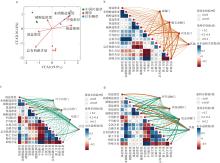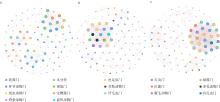Journal of Tropical Oceanography ›› 2025, Vol. 44 ›› Issue (5): 86-96.doi: 10.11978/2025003CSTR: 32234.14.2025003
• Marine Biology • Previous Articles Next Articles
Community structure of rhizosphere eukaryotic microorganisms and its influencing factors of three seagrass species along the coast of Shandong Province
YU Zhen( ), GUO Xiangrui, LIU Xuerui, SUN Hao, ZHANG Yanying(
), GUO Xiangrui, LIU Xuerui, SUN Hao, ZHANG Yanying( )
)
- Ocean School, Yantai University, Yantai 264005, China
-
Received:2025-01-02Revised:2025-01-24Online:2025-09-10Published:2025-10-14 -
Contact:ZHANG Yanying -
Supported by:National Natural Science Foundation of China(41976147); Natural Science Foundation of Shandong Province(ZR2024MD008)
CLC Number:
- P735.121
Cite this article
YU Zhen, GUO Xiangrui, LIU Xuerui, SUN Hao, ZHANG Yanying. Community structure of rhizosphere eukaryotic microorganisms and its influencing factors of three seagrass species along the coast of Shandong Province[J].Journal of Tropical Oceanography, 2025, 44(5): 86-96.
share this article
Add to citation manager EndNote|Reference Manager|ProCite|BibTeX|RefWorks
Tab. 1
Analysis of α diversity indices of eukaryotic microorganisms in the rhizosphere of seagrasses"
| 多样性指数 | 中国川蔓草 | 鳗草 | 日本鳗草 | P |
|---|---|---|---|---|
| Ace指数 | 243.50±93.61 | 321.50±196.5 | 321.80±138.10 | 0.7351 |
| Chao指数 | 235.10±92.07 | 319.90±191.90 | 316.90±138.30 | 0.7351 |
| 香农指数 | 2.92±0.8002 | 3.07±1.18 | 2.15±1.31 | 0.5950 |
| 辛普森指数 | 0.13±0.11 | 0.21±0.19 | 0.41±0.31 | 0.1988 |

Fig. 4
Analysis of eukaryotic community composition and relative abundance of major groups in rhizosphere sediments of Ruppia sinensis, Zostera marina and Zostera japonica. (a) Community composition at phylum level; (b) community composition at genus level; (c) intergroup difference analysis at phylum level; (d) intergroup difference analysis at genus level"


Fig. 6
Relationships between seagrass rhizosphere eukaryotic microbial communities and environmental factors. (a) CCA analysis of seagrass rhizosphere eukaryotic microorganisms and environmental factors; (b), (c), and (d) are the correlation coefficients between the environmental factors and major eukaryotic species in the rhizosphere of Ruppia sinensis, Zostera marina and Zostera japonica"

| [1] |
凌娟, 梁童茵, 岳维忠, 等, 2023. 热带海草泰来草沉积物真菌的群落结构、功能与分子生态网络研究[J]. 热带海洋学报, 42(5): 64-75.
|
|
|
|
| [2] |
刘鹏远, 2022. 黄渤海日本鳗草沉积物三域微生物的分布特征、生态功能及驱动因素[D]. 烟台: 中国科学院大学(中国科学院烟台海岸带研究所).
|
|
|
|
| [3] |
刘鹏远, 张海坤, 陈琳, 等, 2019. 黄渤海海草分布区日本鳗草根际微生物群落结构特征及其功能分析[J]. 微生物学报, 59(8): 1484-1499.
|
|
|
|
| [4] |
宋增磊, 2023. 微生物在黄河三角洲互花米草与日本鳗草生态竞争中的作用及机制分析[D]. 烟台: 中国科学院大学(中国科学院烟台海岸带研究所).
|
|
|
|
| [5] |
孙延瑜, 2021. 威海泻湖海草床共附生微生物群落结构特征及硫入侵过程[D]. 烟台: 中国科学院大学(中国科学院烟台海岸带研究所).
|
|
|
|
| [6] |
孙延瑜, 宋增磊, 刘鹏远, 等, 2021. 威海天鹅湖大叶藻(Zostera marina)与日本鳗草(Zostera japonica)根际微生物群落结构及其驱动机制[J]. 微生物学报, 61(9): 2675-2692.
|
|
|
|
| [7] |
王天雨, 2023. 山东东部沿海两种海草根际微生物群落结构及潜在功能[D]. 烟台: 烟台大学.
|
|
|
|
| [8] |
徐少春, 2021. 黄渤海鳗草(Zostera marina)种群特征及生态修复研究[D]. 青岛: 中国科学院大学(中国科学院海洋研究所).
|
|
|
|
| [9] |
薛曌, 王兰, 孟华旦尚, 等, 2023. 色林错表层水体真核微生物多样性和群落分布格局[J]. 冰川冻土, 45(5): 1652-1666.
|
|
|
|
| [10] |
于培, 2017. 鳗草对沉积物微生物群落的影响及其氮代谢的初步研究[D]. 济南: 山东大学.
|
|
|
|
| [11] |
张晓珂, 梁文举, 李琪, 2018. 我国土壤线虫生态学研究进展和展望[J]. 生物多样性, 26(10): 1060-1073.
|
|
|
|
| [12] |
周毅, 江志坚, 邱广龙, 等, 2023. 中国海草资源分布现状、退化原因与保护对策[J]. 海洋与湖沼, 54(5): 1248-1257.
|
|
|
|
| [13] |
|
| [14] |
|
| [15] |
|
| [16] |
|
| [17] |
|
| [18] |
|
| [19] |
|
| [20] |
|
| [21] |
|
| [22] |
|
| [23] |
|
| [24] |
|
| [25] |
|
| [26] |
|
| [27] |
|
| [28] |
|
| [29] |
|
| [30] |
|
| [31] |
|
| [32] |
|
| [33] |
|
| [34] |
|
| [35] |
|
| [36] |
|
| [37] |
|
| [38] |
|
| [39] |
|
| [40] |
|
| [41] |
|
| [42] |
|
| [43] |
|
| [44] |
|
| [45] |
|
| [46] |
|
| [47] |
|
| [48] |
|
| [49] |
|
| [50] |
|
| [51] |
|
| [52] |
|
| [53] |
|
| [1] | FENG Zhanquan, SU Maoliang, DU Yuanyuan, ZHONG Youling, ZHANG Junbin. MaxEnt model predicting potential distribution of Trichiurus japonicus in the coastal waters of China under global climate change [J]. Journal of Tropical Oceanography, 2025, 44(5): 77-85. |
| [2] | LI Da, WANG Yunzhong, QI Jiguang, YANG Cuihua. Effects of water quality changes on community structures of Symbiodiniaceae and symbiotic bacteria in soft coral Lobophytum sp. [J]. Journal of Tropical Oceanography, 2025, 44(4): 136-144. |
| [3] | SUN Jianing, WANG Yuqing, ZHANG Shouyu, WANG Kai. Structure of macrobenthic community in the seaweed beds of Lvhua Island waters and its response to environmental factors [J]. Journal of Tropical Oceanography, 2025, 44(4): 119-135. |
| [4] | HE Chen, WANG Jianing, ZHOU Linbin, KE Zhixin, LIU Weiwei, LIU Jiaxing, WANG Junxing, TAN Yehui, CHEN Zhiyun. Comparison of macrobenthic community structure between seagrass beds in Xincungang and Li’angang, Hainan [J]. Journal of Tropical Oceanography, 2025, 44(4): 106-118. |
| [5] | DAI Li, PAN Huakang, LIU Liyang, HE Jian, ZHAO Ke, QI Jianfei, ZHANG Zhen, SU Pei, FENG Danqing. Effects of environmental factors on larval settlement and metamorphosis of the fouling organism Mytilopsis sallei [J]. Journal of Tropical Oceanography, 2025, 44(3): 121-129. |
| [6] | ZHOU Zhixi, TANG Huijuan, KE Zhixin, LIU Jiaxing, ZHOU Weihua. Phytoplankton community structure and its relationship with environmental factors in the spring coastal region of Nan’ao based on morphology and high-throughput sequencing [J]. Journal of Tropical Oceanography, 2025, 44(1): 53-65. |
| [7] | LIU Yuan, KE Zhixin, LI Kaizhi, TAN Yehui, LIANG Junce, ZHOU Weihua. Zooplankton community in the coastal waters of eastern Guangdong under the influence of human activities and ocean currents [J]. Journal of Tropical Oceanography, 2024, 43(4): 98-111. |
| [8] | LIU Didi, ZHANG Xiyang, SUN Fulin, WANG Mingzhuang, TAN Fei, SHI Qi, WANG Guan, YANG Hongqiang. Microbial communities and specific strains within beachrocks of the South China Sea: implications for the origin of beachrock* [J]. Journal of Tropical Oceanography, 2024, 43(4): 112-122. |
| [9] | HU Simin, ZHOU Tiancheng, ZHANG Chen, LIU Sheng, LI Tao, HUANG Hui. Effect of suspended solids on zooplankton community and their feeding selectivity in the Sanya coral waters [J]. Journal of Tropical Oceanography, 2024, 43(3): 122-130. |
| [10] | LUO Yong, HUANG Lintao, YANG Jianhui, LIAN Jiansheng, LIU Chengyue, JIANG Lei, LIANG Yuxian, CHEN Lunju, LEI Xinming, LIU Sheng, HUANG Hui. Community structure of reef-building corals and their environmental impact factors in the coastal waters of Hongpai-Maniao, Lingao, Hainan [J]. Journal of Tropical Oceanography, 2024, 43(3): 72-86. |
| [11] | GENG Wanlu, XING Yongze, ZHANG Qiufeng, GUAN Weibing. Structural characteristics of macrobenthic communities at intertidal zone for mangrove in Beihai, Guangxi [J]. Journal of Tropical Oceanography, 2024, 43(1): 107-115. |
| [12] | ZHANG Lanlan, CHENG Xiawen, XIANG Rong, QIU Zhuoya, CHANG Hu. Changes of radiolarian community structure with depth in the central Bay of Bengal in spring 2019 [J]. Journal of Tropical Oceanography, 2023, 42(4): 166-175. |
| [13] | SONG Xingyu, LIN Yajun, ZHANG Liangkui, XIANG Chenhui, HUANG Yadong, ZHENG Chuanyang. Distribution characteristics and influencing factors of meso- and micro-zooplankton communities in the offshore waters of the Guangdong-Hong Kong-Macao Greater Bay Area* [J]. Journal of Tropical Oceanography, 2023, 42(3): 136-148. |
| [14] | CHEN Jingfu, ZHONG Yu, WANG Lei, GUO Yupei, QIU Dajun. Noctiluca scintillans effects on eukaryotic plankton community structure using Environmental DNA analysis in Daya Bay* [J]. Journal of Tropical Oceanography, 2022, 41(5): 121-132. |
| [15] | MA Wengang, XIA Jingquan, WEI Yifan, YIN Hongyang, QIN Lezheng, LIU Xiangbo, HU Xueqing, XU Qiang, LI Xiubao, WANG Aimin. Community structure evaluation of epifaunal macrozoobenthos in the near-island waters of marine ranching in Wuzhizhou Island, Sanya [J]. Journal of Tropical Oceanography, 2022, 41(3): 135-146. |
|
||









